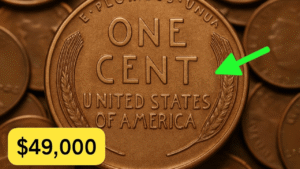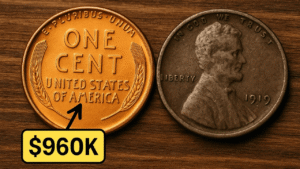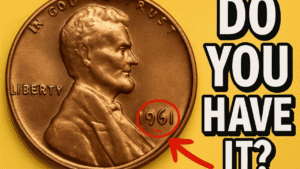Ever buy a box of Cheerios and accidentally score a multi-thousand-dollar coin? No! Well, someone did. And it’s part of one of the strangest, most slept-on stories in modern American money. It involves a teenage Native American guide, a failed dollar coin campaign, a General Mills promo stunt, and a rare minting error that somehow led to a coin being valued at $2.1 million.
Yep. A coin you could’ve found in your pocket change. Or floating around in a forgotten kitchen drawer. Or hiding in a dusty box of Y2K memorabilia in your mom’s attic.
Let’s unravel how the Sacagawea dollar went from gas station fodder to coin collector legend.
First, What’s the Deal with the Sacagawea Dollar?
In 2000, the U.S. Mint decided to replace the wildly unpopular Susan B. Anthony dollar (which people kept confusing with quarters, RIP) with a new golden-hued dollar coin. Enter Sacagawea: the teen Shoshone girl who guided Lewis and Clark across the western frontier.
Her likeness—quiet, strong, and holding her baby Jean Baptiste—was etched into U.S. currency for the first time ever. The idea was to create a coin Americans would actually use. One that honored both Native American heritage and a real historical figure.
But… it kinda flopped.
Sure, over a billion were minted. But Americans just didn’t love dollar coins. Most ended up in vaults, vending machines, or forgotten piggy banks. Which is why you’ll occasionally get one as change at the post office and wonder, “Wait, they still make these?”
Spoiler: they do. Just not many.
But Here’s Where Things Get Wild: The $2.1 Million Coin
Back when the Sacagawea dollar was in its infancy, the U.S. Mint did what the U.S. Mint always does: experiment. They tested different dies, different materials, and different combinations—trying to get the perfect coin.
One of those early test strikes—called a pattern coin—was accidentally struck using the reverse of a Washington quarter. Yeah. A quarter back on a dollar front.
A mismatched Frankenstein of a coin.
How it left the Mint is still a mystery. But somehow, one of these experimental Sacagawea/Quarter hybrids ended up in the hands of a private collector. And years later, it would make headlines when it was valued at $2.1 million.
Why?
Because it’s one-of-a-kind.
Because it’s a certified minting error.
Because coin collectors are wild for this kind of thing.
It’s the holy grail of modern U.S. currency. And it wasn’t even supposed to exist.
The Cereal Box Coin That’s Worth Thousands
As if the million-dollar pattern coin wasn’t enough, the Sacagawea dollar has another twist: the “Cheerios Dollar.”
Back in 2000, General Mills and the U.S. Mint did a promo where 5,500 Sacagawea dollars were tucked into boxes of Cheerios. Just a fun PR move, right?
Turns out, those early promo coins weren’t exactly the same as the regular ones.
The eagle on the back had more detailed tail feathers. A small difference, sure—but in coin collecting, small differences = big money. Today, these “Cheerios Dollars,” in uncirculated condition, can go for $5,000 to $25,000. Some have even surpassed that at auction.
Imagine pouring out a bowl of cereal and landing a college tuition payment.
How to Spot a Rare Sacagawea Dollar
Most Sacagawea dollars are just worth $1. That’s it. But there are a few variations that are worth a closer look. If you’ve got some lying around, here’s what to check:
| Feature | What to Look For | Value Potential |
|---|---|---|
| Year 2000 | Especially early 2000 issues | Up to $25,000+ |
| Tail Feathers Detail | Look closely at the eagle’s tail—Cheerios Dollars have more lines | $5,000+ |
| Wrong Planchet/Mint Errors | Off-metal strikes or wrong die usage | Up to $2 million |
| Clean Condition | Uncirculated or proof-like coins | Much higher value |
And remember: don’t clean it. Ever. That weird gunk on the surface? It’s part of the story. Cleaning a rare coin is like repainting a Picasso because the frame was dusty.
Got One? Here’s What to Do
If you think your dollar coin looks a little odd or special, get it graded. Don’t take it to your buddy’s pawn shop or some shady eBay dealer.
Use trusted services like:
- PCGS (Professional Coin Grading Service)
- NGC (Numismatic Guaranty Company)
They’ll tell you exactly what you have, authenticate it, and give it a grade—just like baseball cards. A “MS-68” rating could mean serious cash.
So… Should You Start Checking Your Change?
If you’re hoping to stumble into a $2 million payday, let’s be honest: chances are low. Like, really low. Most of the crazy-valuable versions are already in collectors’ hands or in museums.
But here’s the thing: it’s not zero.
People find wild stuff in estate sales, old purses, junk drawers, and garage bins all the time. Coin collectors love telling stories about big finds in the most random places.
Besides, there’s a weird kind of joy in sorting through coins. You’re literally touching history. A coin minted in 2000 is now 25 years old. Where’s it been? How many hands has it passed through? What vending machines did it jam?
And maybe—just maybe—you’ll find something that changes your life.
Or, at the very least, a $1 coin that’s worth enough to buy you a beach weekend and a fancy dinner.
FAQs
Is the Sacagawea dollar made of real gold?
Nope. It’s a golden color, thanks to a manganese-brass alloy. No actual gold content.
How do I know if my dollar coin is valuable?
Look for 2000-dated coins, especially ones with the detailed eagle tail feathers. Then get it checked by PCGS or NGC.
Was a Sacagawea dollar really sold for $2.1 million?
Yes. One error coin with a quarter reverse was privately valued and sold for that price due to its unique nature.
Are Cheerios Dollars still out there?
Yep, but they’re rare. Most were kept, lost, or forgotten. A few still surface every now and then.
Should I polish my coin to make it look new?
Absolutely not. Cleaning destroys the value. Keep it as-is.



